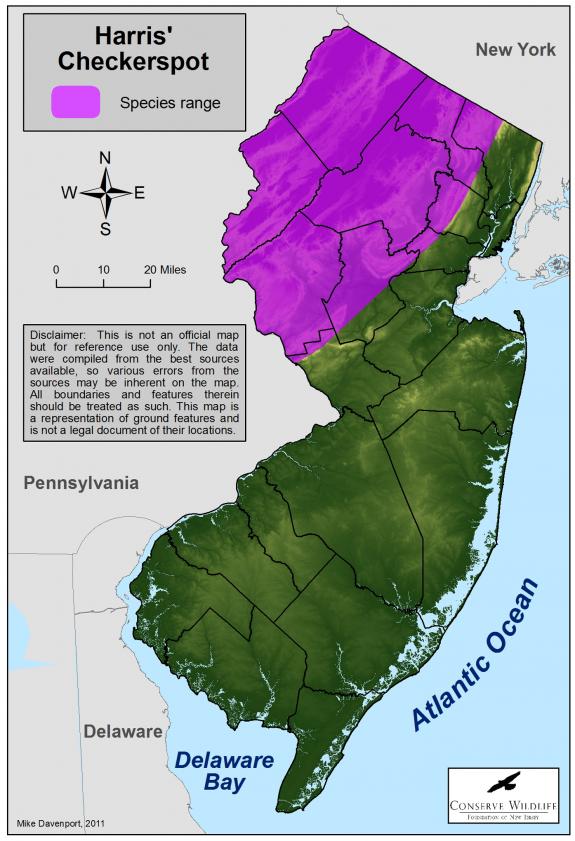Chlosyne harrisii
Type: invertebrate
Status: special concern
Species Guide
Harris' checkerspot
Chlosyne harrisii
Species Type: invertebrate
Conservation Status: special concern
IDENTIFICATION
The Harris’ checkerspot is a small butterfly with a 1 ¼ – 1 ¾ inch wingspan. They are rich orange in base color with wide black borders that help to distinguish them from other similar butterflies. The Harris’ checkerspot is most similar to the rare silvery checkerspot and the smaller pearl crescent. Both species lack the heavy black pattern that sets off the orange and white, creating the checker-like pattern the Harris’ checkerspot has. The larvae of this species is orange with black bands, branched spines, and a black head.

Distribution & Habitat
Harris’ checkerspots have a fairly widespread range. They are found in Canada east to New England, south to New Jersey and west to North Dakota. Preferring a wetland habitat, Harris’ checkerspots are typically in bogs, marshes, moist to wet meadows, abandoned pastures, and along streams. Seldom found far from their food plant, they favor open, shrubby or edge areas where their food plant is readily available.
Diet
During the larval stage, Harris’ checkerspots are found exclusively on flat-topped aster. Flat-topped aster is a common widespread plant of open, wetland habitat. Adults feed on the nectar of a variety of flowers. Flat-topped aster is believed to be the primary food source for both larvae and adults.
Life Cycle
Female Harris’ checkerspots lay an average of 200 eggs in small clusters on the underside of a plant. It is possible the female will lay her eggs on several different plants. After hatching, the larvae will feed communally and devour their natal leaf. Working their way down the plant, they form a web while they feed. They continue feeding until mid-August when they will disappear from their webs and overwinter in the leaf litter of plants. Harris’ checkerspots then emerge from June-July when they will have one flight and begin the cycle again.
Current Threats, Status, and Conservation
In New Jersey, the Harris’ checkerspot is listed as a species of Special Concern. They are not currently listed on a federal level. The Harris’ checkerspot is considered to be a widespread colonizer that is adaptable to a variety of habitats. There are some concerns over habitat loss and negative impacts from the invasive purple loosestrife. Overall, the Harris’ checkerspot is a fairly common butterfly with some local threats to the southeastern portion of their range.
HOW TO HELP
The Endangered and Nongame Species Program would like for individuals to report their sightings of Harris’ checkerspots. Record the date, time, location, and condition of the animal and submit the information by submitting a Sighting Report Form. The information will be entered into the state’s natural heritage program, commonly referred to as Biotics. Biologists map the sighting and the resulting maps “allow state, county, municipal, and private agencies to identify important wildlife habitats and protect them in a variety of ways. This information is used to regulate land-use within the state and assists in preserving endangered and threatened species habitat remaining in New Jersey.”
References
Text written by Emily Heiser in 2011.
Scientific Classification
- Kingdom: Animalia
- Phylum: Arthropoda
- Class: Insecta
- Order: Lepidoptera
- Family: Nymphalidae
- Genus: Chlosyne
- Species: C. harrisii